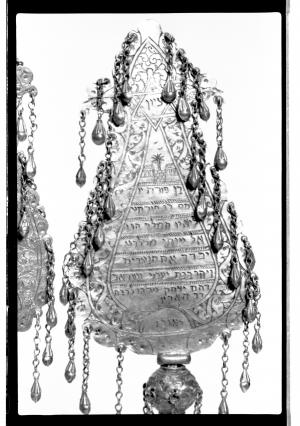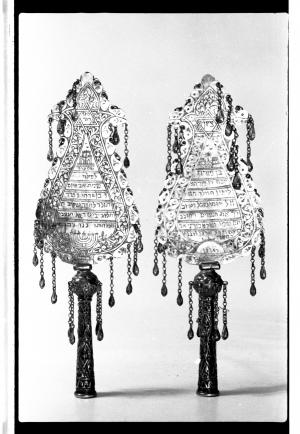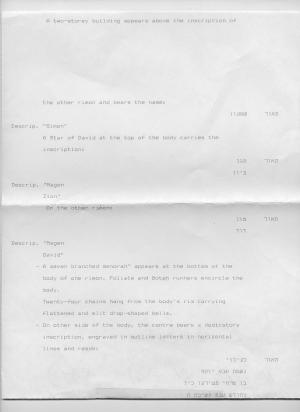Obj. ID: 6712
Sacred and Ritual Objects Torah finials, Afghanistan, 1978

The flat tulip-shaped finial consists of a shaft and a body.
The cylindrical tapering shaft is decorated with a net of rhombuses enclosing flowers. The upper and lower borders are encircled by a foliate ring. The shaft is surmounted by a globular capital decorated with a pattern of scales.
The flat body is inscribed and decorated on both sides; on top is a Star of David enclosing the word Zion, on the front Magen Zion (the shield of Zion), on the back, below the star are depictions of two sites: in front is the Western Wall topped by a palm tree, and flanked by two structures, representing the Temple-site and Solomon's School (Midrash Shlomo). Behind it is a walled city, inscribed "Simeon", representing the city of Shechem (Nablus). Below the inscription on the front is the sign of the tribe Reuben, represented as a rising sun and inscribed "Reuben", while on the back beneath the inscription is the seven-branched menorah (see: Remarks: nos. 1, 2).
The Hebrew inscriptions are engraved in linear characters. The front is inscribed with Jacob's blessing to Joseph and sons, Ephraim and Manasseh (Gen. 49:22; 48:16; with some misspellings):
"בן פורת יו/סף בן פורת ע/לי אין (עין) (בראשית מט:כב) המל(א)ך הגו/אל ייתי (אותי) מכל רע/ יברך את הנערים/ ויקר(א) בכם (בהם) שמי ושר (ושם) [אבותי]/ אב/רהם יצחק וידגו לר(ב) בק/רב הארץ " (בראשית מח: טז).
are misspelled,
The back encloses a dedicatory inscription:
"לעילוי/ נשמת אבא יוסף/ בן מרחי פטירתו כ"ד/ לחודש טבת תשל"ח/ תל אביב ישראל תנצבה (תהא נשמתו צרורה בצרור החיים)/ מנוחתו בגן עדן"
"For the exaltation of the soul of Abba Joseph, Ben Marhi, who passed away on the 24th of the month of Tevet (5)738 (3.1.1978) Tel Aviv, Israel, may his soul be bound in the bond of life, May he rest in Eden."
A band formed by a running almond-shaped (boteh) pattern, frames both inscriptions. Chains are suspended from the body's rim and the globular capital, carrying flattened and slit drop-shaped bells.
Remarks:
- The rationale for choosing to depict two particular Tribes: Reuben and Simeon, is not clear. We do know that the visual depiction of the signs of the Tribes of Israel appeared in Jewish art, at the end of the nineteenth century, and the beginning of the twentieth, as part of the Zionist movement. A similar phenomenon is seen among the Bukharian and the Mountain Jews (Caucasus), who share common origins and a similar Persian cultural environment. For example see the group of finials from Kubachi in Dagestan (Sc. 477-4). For further reading on the depiction of the Tribes in Jewish Art see: Amar, The Tribes, Lexical Definition; Amar, L'art et L'artiste, 163-197. The Depiction of the Tribes in the Persian Jewish environment, cf. Amar, "Crown, Quill, and Crest" pp. 52 – 53, 62.
- The depiction of the Western Wall as a bricked wall flanked by two domes and topped by a palm tree, is a local visual interpretation of the holy site, as was customarily illustrated in Eretz Israel during the nineteenth century. The cypresses were replaced by a palm tree, and the structures, representing Midrash Shlomo and the Temple site, were depicted as two ordinary buildings. A similar depiction, identified and inscribed "כתל מערבי" "Western Wall", is depicted on Afghani ritual objects, made in the same period as two drinking bowls (Hanegbi, Afghanistan,pp.172 – 173, figs. 73, 74). For a similar visual convention see, Fisher, "Omanut ha-me'ah ha- teshah esre, be'eretz Israel" in Omanut ve-umanut, Jerusalem, 1979, pp. 96 – 100.
- The inscriptions on both finials are similar, and are crudely engraved including errors and misspelled words. It seems that the silversmith who engraved the inscriptions copied them without understanding their meaning; the words are at times not divided correctly or the letters are incorrect. These errors may indicate the work of a non-Jewish silversmith or Jewish artisans unfamiliar with the Hebrew language.
- The rationale for choosing to depict two particular Tribes: Reuben and Simeon, is not clear. We do know that the visual depiction of the signs of the Tribes of Israel appeared in Jewish art, at the end of the nineteenth century, and the beginning of the twentieth, as part of the Zionist movement. A similar phenomenon is seen among the Bukharian and the Mountain Jews (Caucasus), who share common origins and a similar Persian cultural environment. For example see the group of finials from Kubachi in Dagestan (Sc. 477-4). For further reading on the depiction of the Tribes in Jewish Art see: Amar, The Tribes, Lexical Definition; Amar, L'art et L'artiste, 163-197. The Depiction of the Tribes in the Persian Jewish environment, cf. Amar, "Crown, Quill, and Crest" pp. 52 – 53, 62.
- The depiction of the Western Wall as a bricked wall flanked by two domes and topped by a palm tree, is a local visual interpretation of the holy site, as was customarily illustrated in Eretz Israel during the nineteenth century. The cypresses were replaced by a palm tree, and the structures, representing Midrash Shlomo and the Temple site, were depicted as two ordinary buildings. A similar depiction, identified and inscribed "כתל מערבי" "Western Wall", is depicted on Afghani ritual objects, made in the same period as two drinking bowls (Hanegbi, Afghanistan,pp.172 – 173, figs. 73, 74). For a similar visual convention see, Fisher, "Omanut ha-me'ah ha- teshah esre, be'eretz Israel" in Omanut ve-umanut, Jerusalem, 1979, pp. 96 – 100.
- The inscriptions on both finials are similar, and are crudely engraved including errors and misspelled words. It seems that the silversmith who engraved the inscriptions copied them without understanding their meaning; the words are at times not divided correctly or the letters are incorrect. These errors may indicate the work of a non-Jewish silversmith or Jewish artisans unfamiliar with the Hebrew language.













